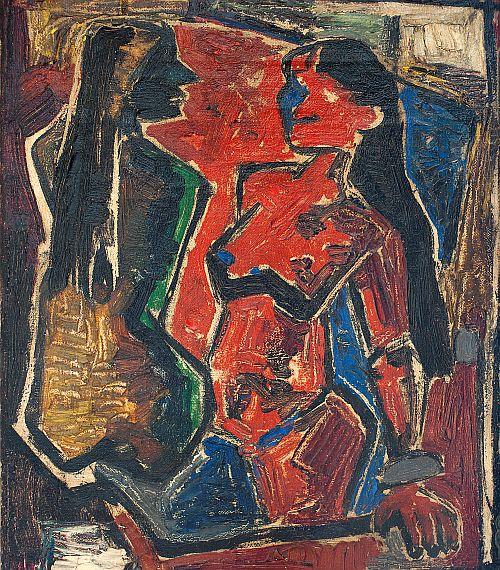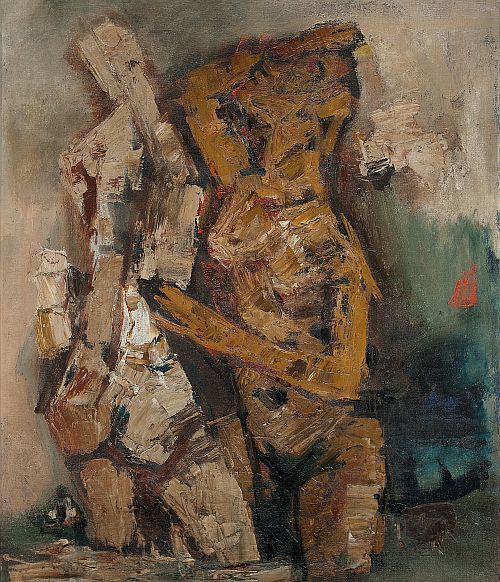Priyanka
Rediff.com's Priyanka reports on the controversy pertaining to a nude art exhibition in New Delhi that has put the moral brigade and the artists at loggerheads
Notwithstanding the outrage of the moral brigade, organisers of an art exhibition that charts the journey of the bare body in Indian art, are trying to put up a brave front.
On at the Delhi Art Gallery, the exhibition -- The Naked and the Nude: The Body in Indian Modern Art -- which showcases the works of 160 artists including M F Hussain, Laxma Goud, Avinash Chandra, P T Reddy and Raja Ravi Varma, has been opposed by the Durga Vahini, the women's wing of the Vishwa Hindu Parishad.
Demanding the immediate closure of the exhibition, Durga Vahini has termed it as "an attempt to treat women as a commodity and mere sex objects".
Sanjana Choudhary, convenor of Durga Vahini's Delhi unit, told rediff.com: "I and a few of my collegaues had seen the paintings at the exhibition. I felt very ashamed of the paitings at the exhibition. How can you show nude painitngs of women in the open?"
"On one hand, we see a rise in crimes against women, and on the other, there are such exhibtions, which show nude and naked paintings of women. We felt that the paintings embarassed the women, and would encourage criminal mentality. We also felt that it does not depict our culture and heritage."
Refuting the charges, gallery owner Kishore Singh told rediff.com: "The exhibition shows a range of styles and artistic exploration. It tells how the naked body, in anguish or fantasy, in a ritual or the erotic, has been rendered in art.
"I am willing to explain what the exhibition is about to anybody. We have had to work hard to put together this exhibition. There is a certain historicity and scholarship to it. The exhibition has tried to chart the journey of the bare body in Indian art.
"The works are very Western inspired, and these are depictions which are now very popular. Many people have argued that there have been paintings at Ajanta and Ellora. But I don't understand why we always need the past to validate our present."
Click on NEXT to go further...
'We have the right to express what we want to say'
Image: M F Husain's painting titled 'Rani' on display at the exhibitionThe artists are more vocal about the brouhaha over the exhibition.
"If they have the right to protest and say what they feel, then we too have the right to express what we want to say," says Gogi Saroj Pal, a participating artist.
Disgusted by the protests, she said, "Art is an expression of an individual. In fact, among the first and the most basic things taught in an art college is how to draw the human form -- a finger, an eye or an ear. Anybody who has had sufficient knowledge of art would know that it is about putting the human form on a canvas."
She explains further, "For an artist, you are painting a human structure, with or without clothes does not matter. You have no objection when a bird or a horse is without clothes. What is the problem with a human structure without drapes? Only uneducated people -- those who do not listen to another person's point of view -- will protest."
"You will find the earliest mentions of art in Vishnudharmottara Purana (a supplement to the Vishnu Purana). It tells how to draw a human body. There are mentions of art in Shiv Purana. And if these people think that art is objectionable, would they be vandalising temples as well," asks Pal.
"Ling and yoni have been in our discourse for so many years. We used to talk about it openly in our society earlier, but now we feel ashamed," Pal laments.
...
'It is not a nude painting, it is just a painting'
Image: Painter Avinash Chandra's untitled art work on show at the Delhi Art GalleryPal has extensive works in 'Kinnari' series (also part of the exhibition at the Delhi Art Gallery), which she describes as a 'myth'.
"Kinnari is a myth; it wants to fly away. It is about the freedom to grow beyond the physical being. And it is created because we want to express a desire to grow beyond the physical. That's it."
Pal takes particular exception to the paintings being called nude.
"It is not a nude painting, it is just a painting. It is human form, a structure. And if they find it objectionable, then nobody is asking them to see it."
"The artist wants the viewer to think what he is seeing and what the art is trying to convey to him," says Pal, adding "My art wants to pinch the viewer, just a little bit, and think of the inequalities a woman as to go through."
The exhibition, which covers works of Indian artists of the 20th century and is on till March 15, is now being held under police supervision.
Click on NEXT to go further...
Top PHOTO features of the week
...




article